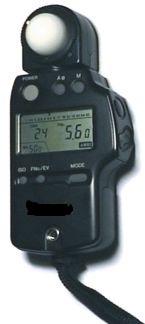Light Meters
Light Meter is a device used to measure the amount of light. In photography, a light meter is often used to determine the proper exposure for a photograph. Typically a light meter will include a computer, either digital or analog, which allows the photographer to determine which shutter speed and f-number should be selected for an optimum exposure, given a certain lighting situation and film speed. Light meters are also used in the fields of cinematography and scenic design, in order to determine the optimum light level for a scene. They are used in the general field of lighting, where they can help to reduce the amount of waste light used in the home, light pollution outdoors, and plant growing to ensure proper light levels.
Early light meters
Actinometers
Actinometers were the first light meters. They typically had the shape of a pocket watch and used light sensitive photo print paper as means of measuring. The time to darken a piece of such paper until it matches a standard tint is the input value for the scales on which an appropriate shutter-speed or aperture combination for the light situation can be found.
Extinction Meters
Another type of early meter, the extinction meter, depended on eyesight: the user looks through the meter at a row of numbers, each behind a celluloid window of different opacity, the highest or lowest visible number determining which light situation is given. Other extinction meters have a pattern visible through the eyepiece, and a control varies the amount of light allowed into the device until the pattern can only just be seen; the position on the control then indicates the exposure.
